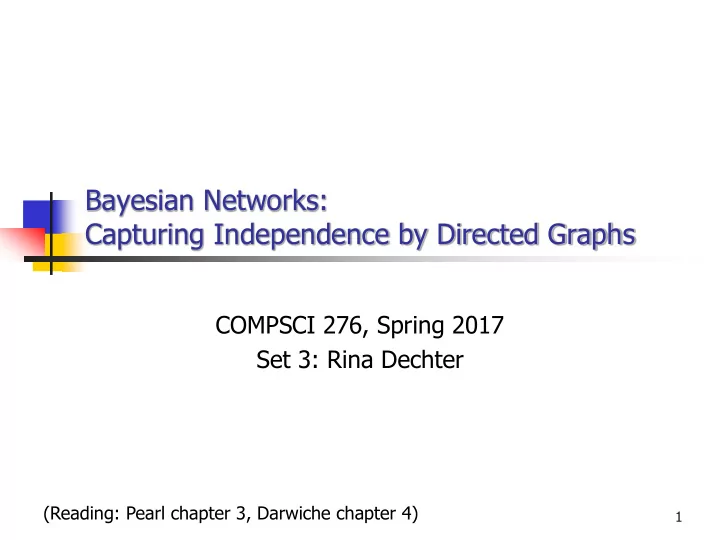

Bayesian Networks: Capturing Independence by Directed Graphs COMPSCI 276, Spring 2017 Set 3: Rina Dechter (Reading: Pearl chapter 3, Darwiche chapter 4) 1
d-separation To test whether X and Y are d-separated by Z in dag G, we need to consider every path between a node in X and a node in Y , and then ensure that the path is blocked by Z . A path is blocked by Z if at least one valve (node) on the path is ‘closed’ given Z . A divergent valve or a sequential valve is closed if it is in Z A convergent valve is closed if it is not on Z nor any of its descendants are in Z . 3
No path Is active = Every path is blocked
Constructing a Bayesian Network for any Distribution P
Bayesian Networks as i-maps E: Employment E V: Investment E E V E H: Health W H W: Wealth C: Charitable C C P contributions P: Happiness Are C and V d-separated give E and P? Are C and H d-separated? 13
I dsep (R,EC,B)?
I dsep (R,EC,B)?
I dsep (R, ∅ ,C)?
¬ I dsep (R, ∅ ,C)?
d-separation using ancestral graph X is d-separated from Y given Z (<X,Z,Y> d) iff: Take the ancestral graph that contains X,Y,Z and their ancestral subsets. Moralized the obtained subgraph Apply regular undirected graph separation Check: (E,{},V),(E,P,H),(C,EW,P),(C,E,HP)? E E E V E W H C C P 18
I dsep ( C,S,B )=?
I dsep ( C,S,B )
We already showed that:
It is not a d-map
Perfect Maps for Dags Theorem 10 [Geiger and Pearl 1988]: For any dag D there exists a P such that D is a perfect map of P relative to d-separation. Corollary 7: d-separation identifies any implied independency that follows logically from the set of independencies characterized by its dag. 25
The ancestral undirected graph G of a directed graph D is An i-map of D. Is it a Markov network of D?
Blanket Examples
Blanket Examples
Markov assumptions in G:
Bayesian Networks as Knowledge-Bases Given any distribution, P, and an ordering we can construct a minimal i-map. The conditional probabilities of x given its parents is all we need. In practice we go in the opposite direction: the parents must be identified by human expert… they can be viewed as direct causes, or direct influences . 31
The role of causality 37
Back to Markov random fields (if time) 39
How can we construct a probability Distribution that will have all these independencies?
Markov Random Field (MRF) So, How do we learn Markov networks From data?
Markov Random Field (MRF) G is locally markov If neighbors make every Variable independent From the rest.
Pearl says: this information must come from measurements or from experts. But what about learning?
Product form over Markov trees
Trees are not the only distributions that have product meaningful forms. They can generalize to join-trees
49
The running intersection property
Recommend
More recommend